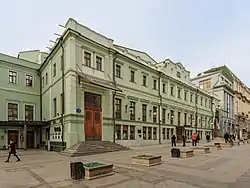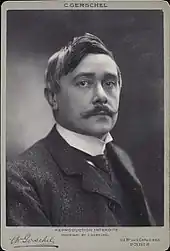Moscow Art Theatre
The Moscow Art Theatre (or MAT; Russian: Московский Художественный академический театр (МХАТ), Moskovskiy Hudojestvenny Akademicheskiy Teatr (МHАТ)) is a theatre company in Moscow. It was founded in 1898 by the seminal Russian theatre practitioner Konstantin Stanislavski, together with the playwright and director Vladimir Nemirovich-Danchenko. It was conceived as a venue for naturalistic theatre, in contrast to the melodramas that were Russia's dominant form of theatre at the time. The theatre, the first to regularly put on shows implementing Stanislavski's system, proved hugely influential in the acting world and in the development of modern American theatre and drama.


Beginnings
At the end of the 19th-century, Stanislavski and Nemirovich-Danchenko both wanted to reform Russian theatre to high-quality art that was available to the general public. They set about creating a private theatre over which they had total control (as opposed to trying to reform the government-operated Maly Theatre, a move which would have given them far less artistic freedom). On 22 June 1897, the two men met for the first time at the Slavyanski Bazar for a lunch that started at 2 PM and did not end until 8 AM the next morning.[1] While Stanislavski’s approach to theatre revolved around the acting process, Nemirovich was far more concerned with the literary, intellectual angle.
Their differences proved to be complementary, and they agreed to initially divide power over the theatre, with Nemirovich in charge of the literary decisions and Stanislavski in charge of all production decisions. Stanislavski interviewed all his actors, making sure they were hard working and devoted as well as talented. He made them live together in common housing for months at a time to foster community and trust, which he believed would raise the quality of their performances. Stanislavski's system, in which he trained actors via the acting studios he founded as part of the theatre, became central to every production the theatre put on.[2] The system played a huge influence in the development of method acting.
Stanislavski and Danchenko’s initial goal of having an “open theatre,” one that anyone could afford to attend, was quickly destroyed when they could neither obtain adequate funding from private investors, nor from the Moscow City Council.[3]
History
The Theatre's first season included works by Aleksey Tolstoy (Tsar Fyodor Ioannovich), Henrik Ibsen, and William Shakespeare, but it wasn’t until it staged Anton Chekhov's four major works, beginning with its production of The Seagull in 1898, with Stanislavski in the role of Trigorin, that the theatre achieved fame. This production was so successful that the theatre adopted the seagull as its emblem.
After Chekhov’s death in 1904, the theatre experienced a huge changeover; Chekhov had envisioned fellow playwright and friend Maxim Gorki as his successor as the Theatre’s leading dramatist, but Nemirovich and Stanislavski’s reaction to his play Summerfolk was unenthusiastic, causing Gorki to leave. He took with him Savva Morozov, one of the theatre’s main investors at the time.[4]
Now in dire straits, the theatre decided to accept invitations to go on an international tour in 1906, which started in Berlin and included Dresden, Frankfurt, Prague, and Vienna. The tour was a huge success, gaining the theatre international acclaim. However, the sudden change in fortune did not completely quell the company's internal strife; Stanislavski appointed friends to the theatre’s management without consulting Nemirovich and opened studios attached to the theatre where he began to implement his acting system, cementing Nemirovich’s fears that the theatre was becoming a mere extension of Stanislavski’s own ideas and work. The tension between the two led Stanislavski to abandon his duties as a board member and to relinquish all his power over policy decisions.[5]
The theatre continued to thrive after the October Revolution of 1917 and was one of the foremost state-supported theatres of the Soviet Union, with an extensive repertoire of leading Russian and Western playwrights. Although several revolutionary groups saw it as an irrelevant marker of pre-revolutionary culture, the theatre was initially granted support by Vladimir Lenin, a frequent patron of the Art Theatre himself. Mikhail Bulgakov wrote several plays for the MAT and satirised the organisation mercilessly in his Theatrical Novel. Isaac Babel's Sunset was also performed there during the 1920s. A significant number of Moscow Art Theatre's actors were awarded the prestigious title of People's Artist of the USSR. Many actors became nationally known and admired thanks to their film roles. However, the Civil War saw many of the theatre’s actors being cut off from Moscow, and the support it received from the government diminished under Lenin’s New Economic Policy. The subsidies it had come to rely on were withdrawn and the theatre was forced to survive on its own profits. By 1923, the MAT was in $25,000 debt.
The theatre experienced further blows through the end of the 1930s. Stanislavski's heart attack onstage during a production of Three Sisters in 1928 led to his almost complete withdrawal from the theatre, while the Stalinist climate began to suppress artistic expression and controlled more and more what could be performed. A "red director" was appointed to the management by the government to ensure that the MAT’s activities were not counter-revolutionary and that they served the Communist cause. As Russia began a period of rapid industrialization, so too was the MAT encouraged to increase production at the expense of quality, with more and more hastily produced plays going up each season. Plays had to be officially approved, and the Theatre’s artistic integrity started to decline.
The theatre was officially renamed The Gorky Moscow Art Theatre in 1932.[6] Desperate not to lose support, Stanislavski tried to appease Stalin by accepting his political limitations on what could be performed while retaining his devotion to naturalistic theatre. As a result, the mid-20th century incarnation of the Moscow Art Theatre took a stylistic turn towards Socialist Realism, which would affect its productions for decades.
It was not until autumn of 1970 that Oleg Yefremov, an actor, producer, and former student of the Moscow Art Theatre Studios who wanted Russia to once again be a major contender in the theatre world, took over control of the theatre and began to reform it. By the time he arrived to save it, the company was made up of only 150 actors, many of whom were out of practice. Yefremov began to reinstate Stanislavski’s traditions, including emphasizing the importance of the studio and of the system, as well as interviewing every single candidate with special emphasis and attention placed on work ethic.[7]
In 1987, the theatre split into two troupes: the Chekhov Moscow Art Theatre (artistic director Oleg Yefremov) and the Gorky Moscow Art Theatre (artistic director Tatiana Doronina). Oleg Tabakov was the Chekhov Moscow Art Theatre's artistic director from 2000 until his death in 2018. The Chekhov Moscow Art Theatre is located just off Tverskaya Street, within walking distance of Red Square.

List of productions
What follows is a full chronological list of MAT productions[8]
1898
1899
- Antigone, by Sophocles
- Hedda Gabler, by Henrik Ibsen
- The Death of Ivan the Terrible, by Aleksey Konstantinovich Tolstoy
- Twelfth Night, by William Shakespeare
- Drayman Henschel, by Gerhart Hauptmann
- Uncle Vanya, by Anton Chekhov
- Lonely People, by Gerhart Hauptmann

1900
1901
- Three Sisters, by Anton Chekhov
- The Wild Duck, by Henrik Ibsen
- Michael Kramer, by Gerhart Hauptmann
- In my Dreams, by Vladimir Nemirovich-Danchenko
1902
1904
1906
- Woe from Wit, by Aleksander Griboyedov (reproduced in 1914)
- Brand, by Henrik Ibsen
1907
1909
- At the Gate of the Kingdom, by Knut Hamsun
- A Month in the Country, by Ivan Turgenev
1910
1911
1912
- Fortune's Fool, A Provincial Lady and It Tears Where It is Thin, by Ivan Turgenev
- Peer Gynt, by Henrik Ibsen
1913
- The Forced Marriage and The Imaginary Invalid by Molière
1914
- The Mistress of the Inn, by Carlo Goldoni
- Pasukhin's Death, by Mikhail Saltykov-Shchedrin
1915
- The Stone Guest, Mozart and Salieri and A Feast in Time of Plague, by Alexander Pushkin
1916-17
Note: When more than one play is listed on the same line, it means that they were produced and performed together.
See also
References
- Benedetti (1991)
- Gauss (1999)
- Benedetti (1991)
- Benedetti (1991)
- Benedetti (1991)
- Magarshack (1950, 383).
- Smeliansky (1999)
- Московский Художественный Театр, Государственное Издательство Изобразительного Искусства, Москва - 1955
Sources
- Banham, Martin, ed. 1998. The Cambridge Guide to Theatre. Cambridge: Cambridge University Press. ISBN 0-521-43437-8.
- Benedetti, Jean. 1991. The Moscow Art Theatre Letters. New York: Routledge.
- Benedetti, Jean. 1999. Stanislavski: His Life and Art. Revised edition. Original edition published in 1988. London: Methuen. ISBN 0-413-52520-1.
- Braun, Edward. 1982. "Stanislavsky and Chekhov". The Director and the Stage: From Naturalism to Grotowski. London: Methuen. 59-76. ISBN 0-413-46300-1.
- Bulgakov, Mikhail. 1996. Black Snow: Theatrical Novel. Trans. Michael Glenny. London: Hodder and Stoughton, 1967. London: Collins-Harvill, 1986, 1991, 1996.
- Gauss, Rebecca B. 1999. Lear's Daughters. New York: Peter Lang.
- Magarshack, David. 1950. Stanislavsky: A Life. London and Boston: Faber, 1986. ISBN 0-571-13791-1.
- Smeliansky, Anatoly. 1999. The Russian Theatre After Stalin. Cambridge: Cambridge University Press.
- Stanislavski, Constantin. 1938. An Actor’s Work: A Student’s Diary. Trans. and ed. Jean Benedetti. London: Routledge, 2008. ISBN 978-0-415-42223-9.
- Whyman, Rose. 2008. The Stanislavsky System of Acting: Legacy and Influence in Modern Performance. Cambridge: Cambridge UP. ISBN 978-0-521-88696-3.
- Worrall, Nick. 1996. The Moscow Art Theatre. Theatre Production Studies ser. London and NY: Routledge. ISBN 0-415-05598-9.
External links
| Wikimedia Commons has media related to Moscow Art Theatre. |
- Official website of the Moscow Art Theatre
- Moscow Art Theatre's channel on YouTube
- "The Moscow Art Theatre: A Model", a 1917 article by N. Ostrovsky.
- Victor Manyukov, Vladimir Prokofyev, Angelina Stepanova, and Vasily Toporkov discuss the Moscow Art Theatre and working with Stanislavski at a 1964 Symposium in New York City. Listen at The WNYC Archives.
